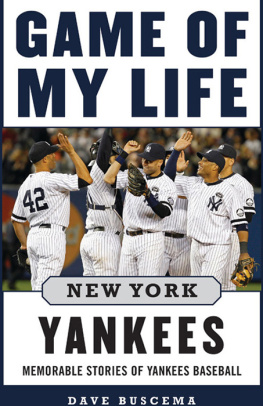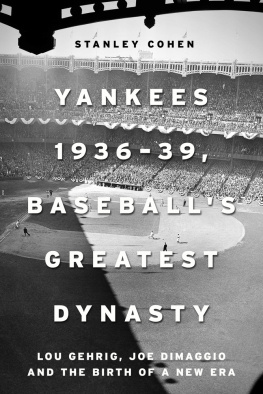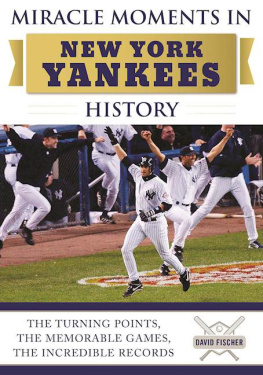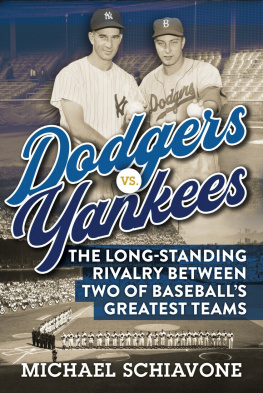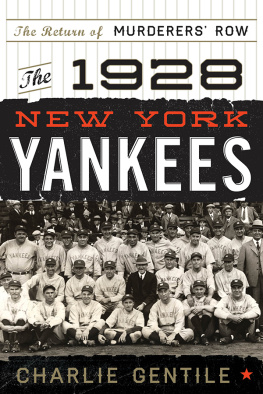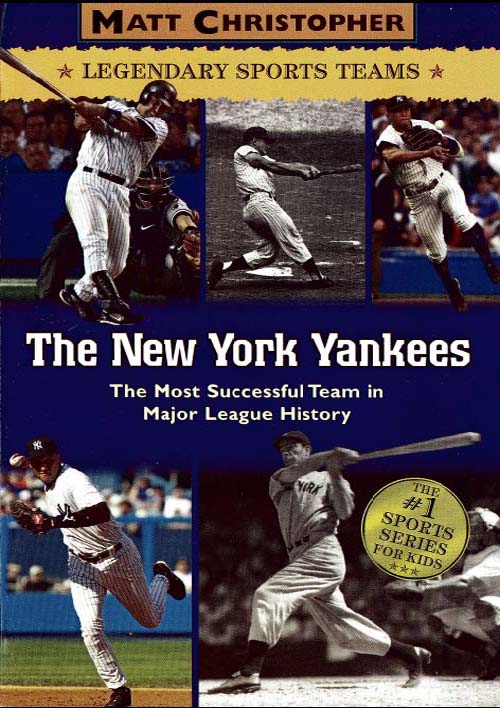Copyright 2008 by Matt Christopher Royalties, Inc.
All rights reserved. Except as permitted under the U.S. Copyright Act of 1976, no part
of this publication may be reproduced, distributed, or transmitted in
any form or by any means, or stored in a database or retrieval system, without
the prior written permission of the publisher.
Little, Brown and Company
Hachette Book Group
237 Park Avenue
New York, NY 10017
Visit our website at www.HachetteBookGroup.com
www.twitter.com/littlebrown
First eBook Edition: December 2009
Matt Christopher is a registered trademark of
Matt Christopher Royalties, Inc.
ISBN: 978-0-316-09446-7
The New York Yankees are the most successful franchise in the history of American professional sports. Since the team was created in 1903, the Yankees have been American League champions 39 times and won the World Series 26 times. No other team in any sport has won so many championships. That record is even more remarkable in light of the fact that in the first 18 years of their existence, the Yankees not only didnt win a World Series title, they didnt even win a pennant. In fact, they were one of the worst teams in baseball!
In 1903 there were two major leagues: the long-established National League, which was founded in 1874, and the upstart American League, which was created in 1901. After competing against each other in 1901 and 1902, the two leagues formally agreed to work together in 1903. As part of that agreement, the National League agreed to allow the American League to put a team in New York.
In early January 1903, Ban Johnson, the president of the American League, decided to move a flagging team from Baltimore to New York. There was only one problem with his plan: the team had no place to play. There were two ballparks in New York City, but both were the home fields of the National League teams. So Johnson needed to build a new park. But where, and how?
The solution didnt come easily. At the time, the government of New York City was controlled by a group of corrupt politicians known as Tammany Hall after the building where they often met. Every time Johnson thought he had found a place to build a ballpark, the politicians found a way to block him. Johnson finally realized that if he sold the team to a member of Tammany Hall, he would be allowed to build a ballpark.
Thats exactly what happened. Johnson agreed to sell the team to two members of Tammany Hall, Frank Farrell, a gambler, and William Devery, the former chief of police of New York City. Soon after, he received permission to build a ballpark in the northern part of Manhattan.
With that issue resolved, Johnson set out to build his team. He had promised Devery and Farrell that the team would be a winner, so he needed quality players and leadership. He got them by cherry-picking other teams.
Clark Griffith, a former pitcher and manager of the 1901 American League champion Chicago White Stockings, became manager of the new team. Star pitcher Jack Chesbro of the Pittsburgh Pirates and outfielder Dave Fultz of the Philadelphia Athletics both made the move to New York, but the big star was outfielder Wee Willie Keeler, who left the Brooklyn Dodgers for the new Manhattan team. Although Keeler wasnt a big man or a slugger, he knew how to hit; he once famously described his approach by saying that he hit em where they aint.
The new team played its first game on April 22 in Washington, D.C., against the Senators, losing, 31. Eight days later, on April 30, they won their first home game, 62, in their new park. The stands in American League Park the official name of the place most knew as Hilltop Park, due to its location on one of the highest points on the island of Manhattan were not quite finished, and parts of the field didnt have any grass. But no one watching the game seemed to mind. They were just enjoying the action.
As of yet the team didnt have an official name. Most fans just called them the Americans, to distinguish the club from New Yorks National League team, the Giants. But within a year some fans and newspaper reporters were referring to the new team as the Highlanders, while others called them the Hilltoppers. Still others called them the Yankees because they played in the northern part of Manhattan and the term Yankee referred to Americans who lived in the northeast. This last name stuck and in 1913, it became official.
Over the course of their first season, the Yankees picked up several more talented players, such as fiery shortstop Kid Elberfeld. By midseason, they were in the pennant race. Then they fell back, finishing in fourth place with a record of 7262, 17 games behind pennant-winning Boston.
In the off-season, Johnson arranged for a few trades to make the Yankees stronger. On opening day in 1904 New York beat Boston, 82, sending the message that the Yankees were just as good as the champions.
The Yankees were particularly successful when Jack Chesbro was on the mound. Chesbro was one of the first pitchers to throw the spitball, a pitch that was legal at the time but has since been banned. Chesbro spit on his fingers then squeezed the ball out like a watermelon seed as he threw it. That wet squeeze made the ball quickly dart toward the ground just as it reached home plate. The pitch was so effective, and Chesbro so strong, that other American League teams usually lost when he pitched.
By seasons end, however, Boston held first place, with a record of 9257 to the Yankees 9056. The two teams were scheduled to play each other five times. The winner of the series would take home the pennant.
The Yankees won the first game, but Boston won the next two. On the last day of the season, October 10, the two teams were scheduled to play a doubleheader. To win the pennant, the Yankees needed to win both games.
Jack Chesbro started the game for New York. Three days earlier, he had beaten Boston for his 41st victory of the season, a modern-day record. The next day he pitched again but lost. Now he was pitching for the third time in four days.
An overflow crowd of 30,000 fans packed every nook and cranny of Hilltop Park that afternoon. In the fifth inning the Yankees squeezed two runs across the plate to take a 20 lead. Then, in the seventh inning, Boston scored two runs to tie it up. The score remained 22 to the top of the ninth. Chesbro and the Yankees needed to hold Boston scoreless while adding a run of their own to win the game.
Bostons first batter, Lou Criger, hit a ground ball to shortstop. Elberfeld fielded it cleanly, but threw the ball into the dirt in front of first. Criger was safe. Then Boston pitcher Bill Dinneen bunted him to second base. The next at bat, Criger went to third base on a ground ball out.
Now Boston shortstop Fred Parent stepped up to the plate. Chesbro was exhausted, but he knew he needed to get at least one more out. He worked the count to one ball, two strikes. Everyone knew he was going to throw a spitball next. That was his best pitch and almost the only pitch he ever threw. In fact, he had already struck out Parent twice on spitballs.
This time, something went wrong. Instead of the ball darting across the plate for strike three, the ball squirted from Chesbros hand and sailed over Fred Parents head. Chesbros catcher Red Kleinow leaped for the pitch, but it was too high. As the ball rattled against the backstop, Criger scrambled home. Boston led, 32!


